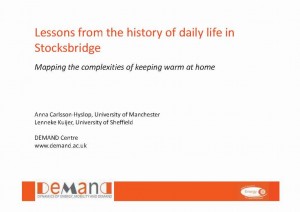Presentation given by Anna Carlsson Hyslop and Lenneke Kuijer to the Stocksbridge & District History Society on Thursday 14 May in Stocksbridge.
Anna and Lenneke presented a set of intermediate results of their research into the histories of council housing from local archives, and the lives lived in them through oral history interviews to forty-five members of the Stocksbridge & District History Society. In their presentation titled ‘Lessons from the history of daily life in Stocksbridge: mapping the complexities of keeping warm at home’ they challenged the idea of historic change in heating as a straightforward change from single coal fires, to gas and electric fires, and central heating. They did so by illustrating the varieties and complexities of historic change in keeping warm at home using examples from their data.
The presentation consisted of three sections. In the first they showed examples of the great variety in heating systems in Stocksbridge that exist next to each other in any point in time and the variety of pathways of change these have followed. In the second section, they illustrated how there is much more to keeping warm than heating systems, think of insulation, portable heaters, clothes, physical activity and space use. In the third, they returned to a discussion of change and acknowledged that things have change over the past century when it comes to keeping warm at home, not the least in levels of energy required to achieve a comfortable indoor climate. The change from coal fires to gas central heating does not in itself explain the increase in energy demand for space heating. Based on their research, they presented three other changes that help with explaining that increase, being: decreases in the work involved in heating the home, which has been largely delegated to automated heating systems; changes in patterns of space heating which relate to what people do inside and outside of the home (e.g. changes in time spent playing outdoors and watching television) and; changes in ideas about what is an acceptably comfortable indoor climate. They finished by briefly reflecting on what these insights on a history of keeping warm at home might mean for the design of measures to achieve reductions in domestic energy demand in the future.
The presentation was well received by the audience, which included a number of people who had been sharing their memories of daily life in Stocksbridge, or had assisted with finding archival material on the history of its council estates. The discussion following the presentation addressed a variety of related topics including the future of heating systems, the effectiveness of double glazing and issues surrounding programmable thermostats.
In a next step, the researchers will use insights gained from the Stocksbridge case study to inspire a diverse group stakeholders to envision low-carbon future ways of keeping warm at home, and pathways towards them.


